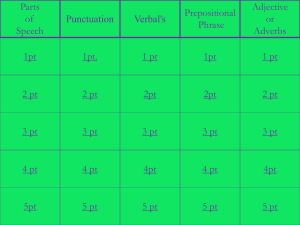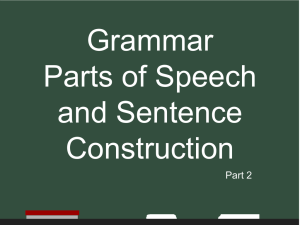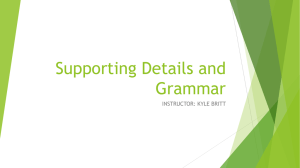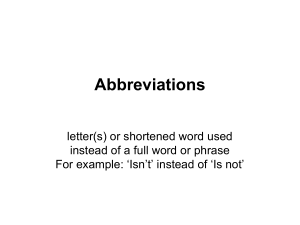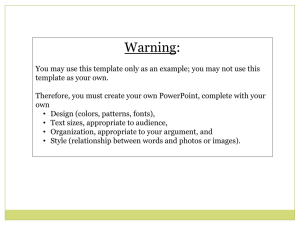Lesson 7
advertisement
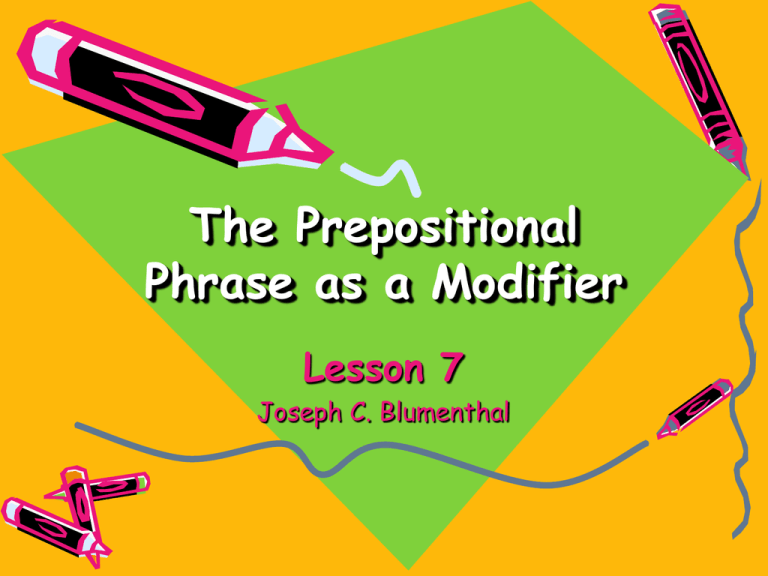
The Prepositional Phrase as a Modifier Lesson 7 Joseph C. Blumenthal The picture…the cover is amusing. Is the picture on, in, near, over, or behind the cover? We need a word to show the relationship between the noun cover and the noun _______. The picture…the cover is amusing. Is the picture on, in, near, over, or behind the cover? We need a word to show the relationship between the noun cover and the noun _picture_. The picture on the cover is amusing. The word that shows the relationship between cover and picture is ________. The picture on the cover is amusing. The word that shows the relationship between cover and picture is ___on___. Jerry strolled…the park. Did Jerry stroll through, past, around, or toward the park? We need a word to show the relationship between the noun park and the verb ________. Jerry strolled…the park. Did Jerry stroll through, past, around, or toward the park? We need a word to show the relationship between the noun park and the verb _strolled_. Jerry strolled through the park. The word that shows the relationship between park and strolled is ______. Jerry strolled through the park. The word that shows the relationship between park and strolled is through. A word that shows the relationship of the noun or pronoun that follows it to some other word in the sentence is called a preposition. A preposition shows a ________ between words. A word that shows the relationship of the noun or pronoun that follows it to some other word in the sentence is called a preposition. A preposition shows a relationship between words. Many prepositions show relationships in position. POSITION: in, on, by, under, below, beneath, above, over, beside, behind, across, against, etc. Which preposition shows position: a. box of crackers b. man from Mars c. car behind us Many prepositions show relationships in position. POSITION: in, on, by, under, below, beneath, above, over, beside, behind, across, against, etc. Which preposition shows position: a. box of crackers b. man from Mars c. car behind us Some prepositions show direction. DIRECTION: to, from, toward, down, up, at The rock rolled down the mountain. The preposition down shows the _________ in which the rock rolled. Some prepositions show direction. DIRECTION: to, from, toward, down, up, at The rock rolled down the mountain. The preposition down shows the _direction_ in which the rock rolled. A few prepositions show relationships in time. TIME: before, during, after, until, till a. Brush your teeth…meals b. Park your car…the corner. Which sentence requires a preposition that will show a time relationship? (a or b?) A few prepositions show relationships in time. TIME: before, during, after, until, till a. Brush your teeth…meals b. Park your car…the corner. Which sentence requires a preposition that will show a time relationship? (a or b?) Still other prepositions, such as of, for, about, with, except and but (when it means except), show many different kinds of relationships between the words they relate. EXAMPLES: a pound of tea a letter for me a story about war a cake with frosting Each of the underlined words is a ___________. Still other prepositions, such as of, for, about, with, except and but (when it means except), show many different kinds of relationships between the words they relate. EXAMPLES: a pound of tea a letter for me a story about war a cake with frosting Each of the underlined words is a preposition. The noun or pronoun that follows a preposition is called its object. The man in the next seat was a doctor. The preposition is in; the object of the preposition is the noun __________. The noun or pronoun that follows a preposition is called its object. The man in the next seat was a doctor. The preposition is in; the object of the preposition is the noun ___seat___. A group of words that begins with a preposition and ends with its objet is a prepositional phrase. The cause of this sudden explosion remains a mystery. The prepositional phrase begins with the preposition of and ends with its object ___________. A group of words that begins with a preposition and ends with its objet is a prepositional phrase. The cause of this sudden explosion remains a mystery. The prepositional phrase begins with the preposition of and ends with its object _ explosion _. We need prepositional phrases to express meanings that cannot be expressed by a single adjective or adverb. a glass for water a water glass a glass for milk a milky glass Which adjective does not have the same meaning as the corresponding prepositional phrase—water or milky? _______ We need prepositional phrases to express meanings that cannot be expressed by a single adjective or adverb. a glass for water a water glass a glass for milk a milky glass Which adjective does not have the same meaning as the corresponding prepositional phrase—water or milky? _milky__ We walked with care. We traveled by train. We walked carefully. We traveled trainly. The adverb carefully can be substituted for the prepositional phrase with care. Is there a proper adverb that can take the place of the phrase by train? (yes, no) We walked with care. We traveled by train. We walked carefully. We traveled trainly. The adverb carefully can be substituted for the prepositional phrase with care. Is there a proper adverb that can take the place of the phrase by train? (yes, no) Most prepositional phrases are used as modifiers—either as an adjective or as an adverb. A prepositional phrase which—like an adjective—modifies a noun or pronoun is called an adjective phrase. An adjective phrase does the work of an ________. Most prepositional phrases are used as modifiers—either as an adjective or as an adverb. A prepositional phrase which—like an adjective—modifies a noun or pronoun is called an adjective phrase. An adjective phrase does the work of an _adjective_. the corner house Because corner modifies the noun house, it is an adjective. the house on the corner Because the prepositional phrase on the corner also modifies the noun house, it is an ________ phrase. the corner house Because corner modifies the noun house, it is an adjective. the house on the corner Because the prepositional phrase on the corner also modifies the noun house, it is an _adjective_ phrase. the corner house the house on the corner The adjective comes before the noun it modifies. The adjective phrase comes (before, after) the noun it modifies. the corner house the house on the corner The adjective comes before the noun it modifies. The adjective phrase comes (before, after) the noun it modifies. Adjective phrases—just like adjectives— are often used after linking verbs such as subject compliments. a. The lilacs are beautiful. b. The lilacs are in full bloom. In which sentence is an adjective phrase used as a subject complement? a or b Adjective phrases—just like adjectives— are often used after linking verbs such as subject compliments. a. The lilacs are beautiful. b. The lilacs are in full bloom. In which sentence is an adjective phrase used as a subject complement? a or b In all but one of these sentences, the linking verb is followed by an adjective phrase used as a subject compliment. a. The plane was on time. b. The piano seems in tune. c. The crops were dry. d. The ring is of no value. The one sentence in which the linking verb is not completed by an adjective phrase is sentence ___. In all but one of these sentences, the linking verb is followed by an adjective phrase used as a subject compliment. a. The plane was on time. b. The piano seems in tune. c. The crops were dry. d. The ring is of no value. The one sentence in which the linking verb is not completed by an adjective phrase is sentence _c_. A prepositional phrase can also be used as an adverb. spoke proudly Because proudly modifies the verb spoke, it is an adverb. spoke with pride Because the phrase with pride also modifies the verb spoke, it is an ________ phrase. A prepositional phrase can also be used as an adverb. spoke proudly Because proudly modifies the verb spoke, it is an adverb. spoke with pride Because the phrase with pride also modifies the verb spoke, it is an __adverb_ phrase. Like the verbs they resemble, adverb phrases answer the questions When? Where? and How? about verbs. The car turned at the next intersection. Which question does the adverb phrase answer: When? Where? How? Like the verbs they resemble, adverb phrases answer the questions When? Where? and How? about verbs. The car turned at the next intersection. Which question does the adverb phrase answer: When? Where? How? During the night it snowed. Which question does the adverb phrase answer: When? Where? How? During the night it snowed. Which question does the adverb phrase answer: When? Where? How? We mended the picture with paste. Which question does the adverb phrase answer: When? Where? How? We mended the picture with paste. Which question does the adverb phrase answer: When? Where? How? An adverb phrase can also answer the question Why? about a verb. a. I often read science fiction for a change. b. I often read science fiction for a few days. In which sentence does the adverb phrase explain Why? in regard to the verb? a or b? An adverb phrase can also answer the question Why? about a verb. a. I often read science fiction for a change. b. I often read science fiction for a few days. In which sentence does the adverb phrase explain Why? in regard to the verb? a or b? An adverb phrase—just like an adverb— can often be moved from one position to another in the sentence. My friend takes a nap after dinner. After dinner my friend takes a nap. The fact that a prepositional phrase can be moved shows that it is an _______ phrase. An adverb phrase—just like an adverb— can often be moved from one position to another in the sentence. My friend takes a nap after dinner. After dinner my friend takes a nap. The fact that a prepositional phrase can be moved shows that it is an _adverb_ phrase. a. They have improved the design of the car. b. A crowd was standing around the car. In one sentence the phrase can be moved; in the other it can’t. Which sentence contains an adverb phrase? a or b? a. They have improved the design of the car. b. A crowd was standing around the car. In one sentence the phrase can be moved; in the other it can’t. Which sentence contains an adverb phrase? a or b? An adverb phrase can usually be shifted about. Therefore it can be several words away from the verb it modifies. a. On the first automobiles, solid rubber tires were used. b. Solid rubber tires were used on the first automobiles. The adverb phrase is farthest from the verb it modifies in sentence. ____ a or b? An adverb phrase can usually be shifted about. Therefore it can be several words away from the verb it modifies. a. On the first automobiles, solid rubber tires were used. b. Solid rubber tires were used on the first automobiles. The adverb phrase is farthest from the verb it modifies in sentence. ____ a or b? A pot of stew was simmering on the stove. This sentence contains both an adjective phrase and an adverb phrase. The adverb phrase is the (first, second) phrase. A pot of stew was simmering on the stove. This sentence contains both an adjective phrase and an adverb phrase. The adverb phrase is the (first, second) phrase. We saw through the telescope the outline of a slip. The adverb phrase is the (first, second) phrase. We saw through the telescope the outline of a slip. The adverb phrase is the (first, second) phrase. When we have two (or more) prepositional phrases in a row, each phrase can modify a different word. We put a drop of water under the microscope. The phrase of water modifies the noun drop. Which word does the adverb phrase under the microscope modify? _______ When we have two (or more) prepositional phrases in a row, each phrase can modify a different word. We put a drop of water under the microscope. The phrase of water modifies the noun drop. Which word does the adverb phrase under the microscope modify? __put__ Two (or more) prepositional phrases can also modify the same word. Dad flew to Houston on Friday. The phrase to Houston modifies the verb flew. Which word does the phrase on Friday modify? _______ Two (or more) prepositional phrases can also modify the same word. Dad flew to Houston on Friday. The phrase to Houston modifies the verb flew. Which word does the phrase on Friday modify? __flew__ A prepositional phrase can modify the object of the preceding prepositional phrase. The family lived on the edge of a great forest. The phrase on the edge modifies the verb lived. Which word does the phrase of a great forest modify? ________ A prepositional phrase can modify the object of the preceding prepositional phrase. The family lived on the edge of a great forest. The phrase on the edge modifies the verb lived. Which word does the phrase of a great forest modify? __edge___ Remember— A prepositional phrase that modifies a noun or a pronoun is called an adjective phrase. A prepositional phrase that modifies a verb is called an _______ phrase. Remember— A prepositional phrase that modifies a noun or a pronoun is called an adjective phrase. A prepositional phrase that modifies a verb is called an _adverb_ phrase. In the following frames, each sentence contains two prepositional phrases in various combinations—two adjective phrases, two adverb phrases, or one of each. Before classifying each phrase, ask yourself, “Does this phrase describe a noun or pronoun, or does it answer a question about the verb. Write the answers on your own sheet of paper. After each letter, indicate whether the corresponding phrase is an adjective or an adverb phrase. (Notice that only one of these phrases can be moved to another position.) The TV program brings the services (a) of a great university (b) into your home. 1. a ___________ phrase 2. b ___________ phrase After each letter, indicate whether the corresponding phrase is an adjective or an adverb phrase. (Notice that only one of these phrases can be moved to another position.) Our mayor is a person (a) with a reputation (b) for great honesty. 3. a ___________ phrase 4. b ___________ phrase After each letter, indicate whether the corresponding phrase is an adjective or an adverb phrase. (Notice that only one of these phrases can be moved to another position.) (a) In several states, the smoke (b) from this forest fire could be clearly seen. 5. a ___________ phrase 6. b ___________ phrase After each letter, indicate whether the corresponding phrase is an adjective or an adverb phrase. (Notice that only one of these phrases can be moved to another position.) The invention (a) of the automobile has changed American life (b) in many ways. 7. a ___________ phrase 8. b ___________ phrase After each letter, indicate whether the corresponding phrase is an adjective or an adverb phrase. (Notice that only one of these phrases can be moved to another position.) (a) At feeding time, a large crowd always gathers (b) around the lion’s cage. 9. a ___________ phrase 10. b ___________ phrase Some words can be used as either prepositions or adverbs. These words, such as before, behind, after, past, through, down, and around, generally refer to direction. To decide how such a word is used, look for an object. If you find an object, the word in question is a ( preposition, adverb ). 11. ____________ a. The dog trotted behind. b. The dog trotted behind the car. In which sentence is behind a preposition because it is followed by an object? (a, b) 12. _____ a. Ralph fell down the stairs. b. Ralph fell down. In sentencee a, down is a preposition because it is followed by the object stairs. 13. In sentence b, down is an adverb that modifies the verb _______. a. The farmers stood around and chatted. b. The farmers stood around the courthouse. 14. In which sentence is around a preposition because it is followed by an object? ________ a. The bus went by without stopping. b. The bus went by the corner without stopping. 15. In which sentence is by a preposition because it is followed by an object? ________ You are done!!!

